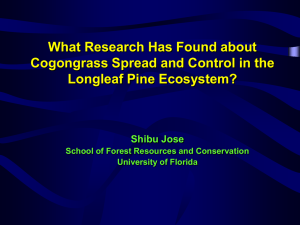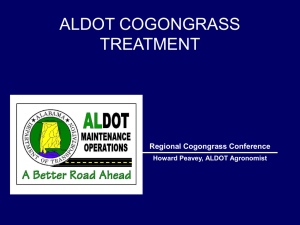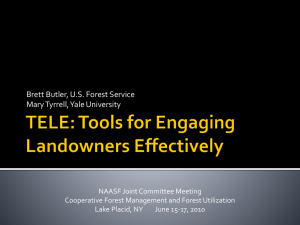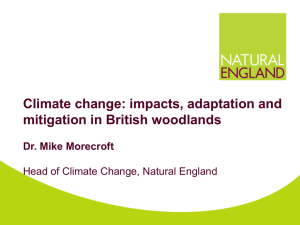The Economic Impact of Cogongrass on Private, Non
advertisement
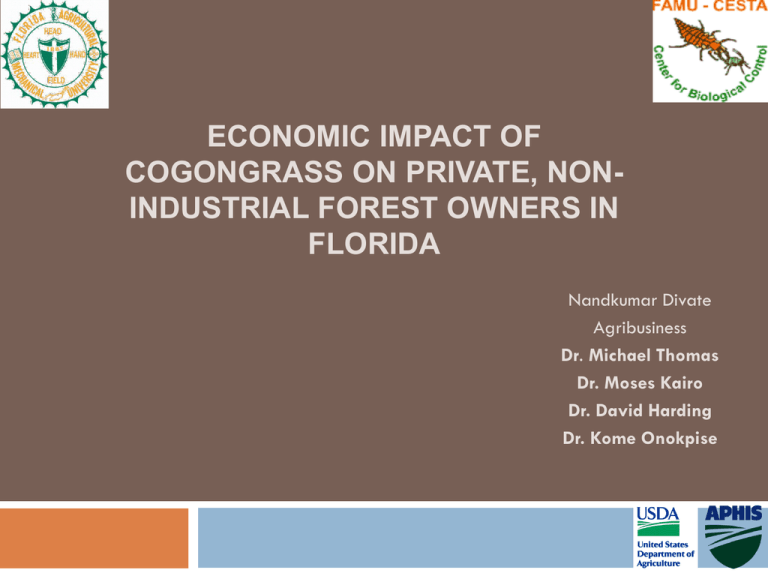
1 ECONOMIC IMPACT OF COGONGRASS ON PRIVATE, NONINDUSTRIAL FOREST OWNERS IN FLORIDA Nandkumar Divate Agribusiness Dr. Michael Thomas Dr. Moses Kairo Dr. David Harding Dr. Kome Onokpise Introduction 2 Native to southeast Asia Infests nearly 500 million acres worldwide Found on every continent Except Antarctica Tropical and subtropical areas, limited spread to northern temperate regions Considered to be one of the worst weeds Introduction to U.S. 3 First appearance Grand Bay, Alabama Escape from crate packing in 1912 Intentional introduction Mississippi as a possible forage in 1921 Florida introduction 1930s and 1940s However, little economic (forage) benefit Worldwide Distribution 4 The general distribution of Imperata cylindrica throughout the world, depicted by areas of white. (Based on information from Holm et al., 1997.) Cogongrass infestation in the southeastern United States 5 Points of introduction Statement of Problem 6 Objectives 7 Develop an instrument to survey owners of private, nonindustrial forestland in Florida and conduct a statewide sample of private, non-industrial forest owners in Florida. Use the sample results to document the direct impact of cogongrass on; - lost forest inventory and reduced forest regeneration and productivity, - and the direct economic impact of control efforts. Apply these estimates of direct economic impact to an input/output economic model and extrapolate the indirect and induced effects of these losses to the economy at large. Methodology 8 A mail survey was designed and sent to 2800 forest owners It asked forest owners about their knowledge of the spread, impact, and control techniques of cogongrass. The instrument has four sections. Survey Instrument 9 Methodology 10 Economic impact of cogongrass will be estimated with input/output (IO) IO analysis tracks direct, indirect and induced economic effects from lost forest productivity and expenditures use to control cogongrass. Results are reported regional and statewide Extrapolate the indirect and induced effects to the economy at large. Data 11 - - Source for List of Private non industrial forest owners Institute of Food and Agricultural Sciences, School of forest research and Conservation, University of Florida 2832 woodland owners in Florida. Targeted Survey Population Survey Results 12 Category Total Mailed Undelivered questionnaires Survey 2,832 350 Adjusted sample size 2,482 Returned questionnaires 1,130 Response rate 45.52% Source: Survey questionnaire Reason For Owning Woodland 13 Reason for Owning Woodland Production of firewood or bio-fuel (energy) Cultivation/collection of non timber forest products Recreation other than hunting & fishing Part of home or vacation home Hunting or fishing Privacy 2.09 2.1 Key Importance on the scale of 1to 5. 1- least important 3.28 3.42 3.51 3.79 Part of farm or ranch 3.8 Production of saw logs, pulpwood or other products 3.8 Financial investment 3.85 Inherit 3.9 Protect biological diversity Beauty or scenery 4.19 4.29 Source: Survey questionnaire Cost share Program Participation 14 Responses % •57% respondents cost-share program. •52 % Used in last five years. 20 18 16 14 12 10 8 6 4 2 0 19.05 Cost share Program Participation 16.39 14.34 12.7 8.81 8.4 7.99 6.96 2.66 2.45 0.2 Source: Survey questionnaire Relative importance of common weeds found in Woodlands 15 Common Weeds Mean Std. Error % Don’t Know Cogongrass 1.86 .052 37.33 Japanese climbing fern 1.76 .053 55.88 Japanese privet 1.72 .058 73.05 Chinese tallow (Popcorn Tree) 1.71 .047 39.27 Blackberry 1.59 .033 17.53 Muscadine grape 1.54 .036 21.85 Tropical soda apple 1.52 .046 52.91 Mimosa 1.50 .037 29.81 Air potato vine 1.39 .038 54.98 Kudzu 1.37 .036 21.51 Japanese honeysuckle 1.33 .033 58.74 Morning glory vine 1.31 .028 34.64 Coral ardisia 1.14 .030 97.95 Mean on the index of 1 to 5 Source of information about Cogongrass 16 • 51% respondents are familiar with cogongrass. Source of Information about Cogongrass 30 27.52 Responces % 25 20 15 10 5 10.55 9.54 8.9 6.24 3.39 3.3 2.2 1.01 0.92 0 Source: Survey questionnaire Cogongrass 17 Awareness about presence of cogongrass (approx. 4.5 years) Presence of Cogongrass (30% & 33% don’t know) Have problem with cogongrass (25 % ) Woodland Covered with cogongrass (5 % ) Negative effect of cogongrass On Tree Growth. (40% believe ) believe Cogongrass, Cause wildfire (54% ) Cogongrass control 18 • 78% Tried to control • Average cost of control $81.56 per acre. • Major chemical – Roundup (83%). Mechanical 9% Other 2% Burning 8% Control Methods Chemical 81% Source: Survey questionnaire Demographic responses 19 Plans for woodland (minimum activity, Harvest and Bequest) Years owning forest property in Florida (Average 22 years) Inherit woodland or forest (33%) Importance of woodland income in household (1.9) Household income earned from woodland (11%) Approx household annual income (Avg $104630.6 ) Private non-industrial forest owners area distribution in Florida. 20 Private non-industrial forest land in Florida by region Southern 11% Central 16% North Eastern 40% North Western 33% Source: Florida division of forestry’s, forest inventory and analysis factsheet (2007). Cost of control model 21 Regional cost of control (RCi) can be calculated as follows RCi = ƒ (Ii, Ai, Pi, Ci) (1) Where: Ii = Cogongrass infestation rate for region i. Ai = number of acres of woodland owned by private nonindustrial individuals in the region i. Pi = proportion of woodland owners trying to control cogongrass in region i. Ci = average cogongrass control cost for region i. (For region i, i = northeastern, northwestern, central & south) Regions with acres Bounds Input for IMPLAN analysis Infestation rate (%) Proportion that Cost of /acre ($) control Regional cost of control ($) control (%) Northeastern 22 (1,949,000) Northwestern (1,608,220) Central (7,79,740) Southern (536,070) State (4,873,030) Average 3.89 74 127.62 7,159,982 Lower 2.89 73.88 43.39 1,808,224 Upper 4.88 74.11 211.85 14,951,489 Average 5.11 78 115.24 7,386,934 Lower 3.6846 77.932 75.3 3,477,890 Upper 6.5354 78.068 155.17 12,731,888 7.022 86 133.64 6,292,824 Lower 3.4304 85.87 10.2 234,280 Upper 10.613 86.13 257,08 18,323,596 4.33 1 76.25 17,699 Lower 0.664 1 0 0 Upper 7.996 1 119.11 51,055 Average 5.009 78 81.56 15,501,506 Lower 3.9946 77.946 63.54 9,641,540 Upper 6.0234 78.054 99.57 22,813,790 Average Average IMPLAN analysis 23 • State wide average Impact $14,933,490. Average Economic Impact of Cogongrass 7,000,000 6,000,000 Impact $ 5,000,000 4,000,000 6,744,703 6,921,156 5,951,266 3,000,000 2,000,000 1,000,000 16,701 0 Northeastern Northwestern Central Southern Region Source: IMPLAN analysis results Detailed IMPLAN analysis Regions Output Direct ($) Indirect ($) Induced ($) Total output ($) Northeastern Average 6,693,955 29,917 20,831 6,744,703 Lower 1,690,531 7,555 5,261 1,703,347 Upper 13,978,331 62,473 43,500 14,084,304 Average 6,906,136 9,179 5,841 6,921,156 Lower 3,251,522 4,321 2,750 3,258,593 Upper 11,903,199 15,820 10,067 11,929,086 5,883,239 42,709 25,318 5,951,266 Lower 219,031 1,590 943 221,561 Upper 17,130,956 124,361 73,722 17,329,039 16,547 98 57 16,701 Lower 0 0 0 0 Upper 47,732 282 163 48,177 14,492,548 272,401 168,542 14,933,490 Lower 9,013,994 169,426 104,829 9,288,249 Upper 21,328,892 400,896 248,045 21,977,834 24 Northwestern Central Southern State Average Average Average Source: IMPLAN analysis results CONCLUSION 25 Cogongrass was ranked by Private Non-industrial Forest Owners as the most common forest weed across the state of Florida. Private Non-industrial Forest Owners are more willing to control Cogongrass using Chemical control rather than Mechanical control. With Cogongrass’s continued spread, it will likely generate more economic losses to the woodland industry. 26 Thank you
